Apache POI PPT - Overview
Many a time, a software application is required to generate reports in Microsoft Office file format. Sometimes, an application is even expected to receive MS- Office files as input data.Any Java programmer who wants to produce MS Office files as output must use a predefined and read-only API to do so.
What is Apache POI?
Apache POI is a popular API that allows programmers to create, modify, and display MS-Office files using Java programs. It is an open source library developed and distributed by Apache Software Foundation. It contains classes and methods to decode the user input data, or a file into MS Office documents.Components of Apache POI
Apache POI contains classes and methods to work on all OLE2 Compound documents of MS-Office. The list of components of this API is given below:- POIFS (Poor Obfuscation Implementation File System) : This component is the basic factor of all other POI elements. It is used to read different files explicitly.
- HSSF (Horrible SpreadSheet Format) : It is used to read and write .xls format of MS-Excel files.
- XSSF (XML SpreadSheet Format) : It is used for .xlsx file format of MS-Excel.
- HPSF (Horrible Property Set Format) : It is used to extract property sets of the MS-Office files.
- HWPF (Horrible Word Processor Format) : It is used to read and write .doc extension files of MS-Word.
- XWPF (XML Word Processor Format) : It is used to read and write .docx extension files of MS-Word.
- HSLF (Horrible Slide Layout Format) : It is used to read, create, and edit PowerPoint presentations.
- HDGF (Horrible DiaGram Format) : It contains classes and methods for MS-Visio binary files.
- HPBF (Horrible PuBlisher Format) : It is used to read and write MS-Publisher files.
Note : Older versions of POI support binary file formats such as doc, xls, ppt, etc. Version 3.5 onwards, POI supports OOXML file formats of MS-Office such as docx, xlsx, pptx, etc.
Flavors of Java PPT API
This chapter takes you through some of the flavors of Java PowerPoint API and their features. There are many vendors who provide Java PPT related APIs; some of them are considered in this chapter.Aspose Slides for Java
Aspose slides for Java is a purely licensed Java PPT API, developed and distributed by the vendor Aspose. The latest version of this API is 8.1.2, released in July 2014. It is a rich and heavy API (combination of plain Java classes and AWT classes) for designing the PPT component that can read, write, and manage slides.The common uses of this API are as follows:
- Build dynamic presentations
- Render and print high-fidelity presentations
- Generate, edit, convert, and print presentations
Apache POI
Apache POI is a 100% open source library provided by Apache Software Foundation. Most of the small and medium scale application developers depend heavily on Apache POI (HSLF + XSLF). It supports all the basic features of PPT libraries; however, rendering and text extraction are its main features. Given below is the architecture of Apache POI for PPT.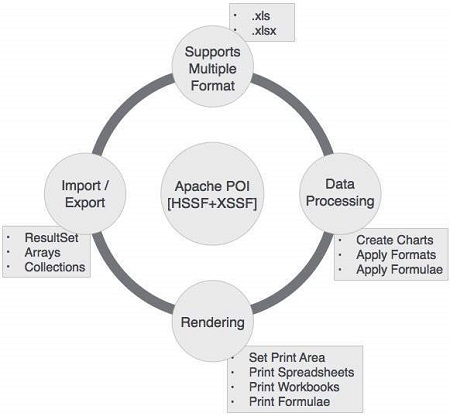
Apache POI PPT - Installation
This chapter takes you through the process of setting up Apache POI on Windows and Linux based systems. Apache POI can easily be installed and integrated with your current Java environment, following a few simple steps without any complex setup procedures. User administration is required for installation.System Requirements
| JDK | Java SE 2 JDK 1.5 or above |
|---|---|
| Memory | 1 GB RAM (recommended) |
| Disk Space | No minimum requirement |
| Operating System Version | Windows XP or above, Linux |
Step 1: Verify your Java Installation
First of all, you need to have Java Software Development Kit (SDK) installed on your system. To verify this, execute any of the following two commands depending on the platform you are working on.If the Java installation has been done properly, then it will display the current version and specification of your Java installation. A sample output is given in the following table.
| Platform | Command | Sample Output |
|---|---|---|
| Windows | Open Command Console and type: \>java –version |
Java version "1.7.0_60" Java (TM) SE Run Time Environment (build 1.7.0_60-b19) Java Hotspot (TM) 64-bit Server VM (build 24.60-b09,mixed mode) |
| Linux | Open Command terminal and type: $java –version |
java version "1.7.0_25" Open JDK Runtime Environment (rhel-2.3.10.4.el6_4-x86_64) Open JDK 64-Bit Server VM (build 23.7-b01, mixed mode) |
- We assume that the readers of this tutorial have Java SDK version 1.7.0_60 installed on their system.
- In case you do not have Java SDK, download its current version from http://www.oracle.com/technetwork/java/javase/downloads/index.html and install it.
Step 2: Set your Java Environment
Set the environment variable JAVA_HOME to point to the base directory location where Java is installed on your machine. For example,| Platform | Description |
|---|---|
| Windows | Set JAVA_HOME to C:\ProgramFiles\java\jdk1.7.0_60 |
| Linux | Export JAVA_HOME=/usr/local/java-current |
| Platform | Description |
|---|---|
| Windows | Append the String "C:\Program Files\Java\jdk1.7.0_60\bin" to the end of the system variable PATH. |
| Linux | Export PATH=$PATH:$JAVA_HOME/bin/ |
Step 3: Install Apache POI Library
Download the latest version of Apache POI from http://poi.apache.org/download.html and unzip its contents to a folder from where the required libraries can be linked to your Java program. Let us assume the files are collected in a folder on C drive.The following images show the directories and the file structures inside the downloaded folder:
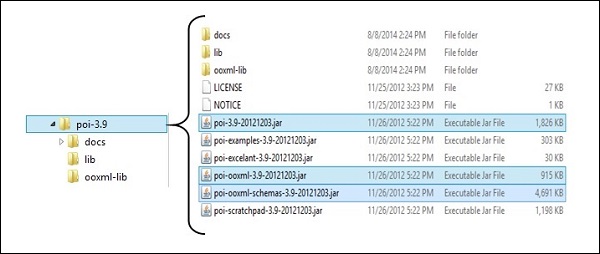
 Add the complete path of the five jars as highlighted in the above image to the CLASSPATH.
Add the complete path of the five jars as highlighted in the above image to the CLASSPATH.| Platform | Description |
|---|---|
| Windows | Append the following strings to the end of the user variable CLASSPATH: “C:\poi-3.9\poi-3.9-20121203.jar;” “C:\poi-3.9\poi-ooxml-3.9-20121203.jar;” “C:\poi-3.9\poi-ooxml-schemas-3.9-20121203.jar;” “C:\poi-3.9\ooxml-lib\dom4j-1.6.1.jar;” “C:\poi-3.9\ooxml-lib\xmlbeans-2.3.0.jar;.;” |
| Linux | Export CLASSPATH=$CLASSPATH: /usr/share/poi-3.9/poi-3.9-20121203.tar: /usr/share/poi-3.9/poi-ooxml-schemas-3.9-20121203.tar: /usr/share/poi-3.9/poi-ooxml-3.9-20121203.tar: /usr/share/poi-3.9/ooxml-lib/dom4j-1.6.1.tar: /usr/share/poi-3.9/ooxml-lib/xmlbeans-2.3.0.tar |
Apache POI PPT - Classes and Methods
In this chapter, we will learn about a few classes and methods under Apache POI API that are crucial to work on PPT files using Java programs.Presentation
To create and manage a presentation, you have a class called XMLSlideShow in the package org.apache.poi.xslf.usermodel. Given below are some important methods and a constructor of this class.Class : XMLSlideShow
Package : org.apache.poi.xslf.usermodel
| S.No | Constructor and Description |
|---|---|
| 1 | XMLSlideShow(java.io.InputStream inputStream) You can instantiate this class by passing an inputstream class object to it. |
| S.No | Methods and Description |
|---|---|
| 1 | int addPicture (byte[] pictureData, int format) Using this method, you can add a picture to a presentation. |
| 2 | XSLFSlide createSlide() Creates a blank slide in a presentation. |
| 3 | XSLFSlide createSlide(XSLFSlideLayout layout) Creates a slide with a given slide layout. |
| 4 | java.util.List <XSLFPictureData> getAllPictures() Returns an array of all the pictures in a presentation. |
| 5 | java.awt.Dimension getPageSize() Using this method, you can get to know the current page size. |
| 6 | XSLFSlideMaster[] getSlideMasters() Returns the array of all the slides in a presentation. |
| 7 | XSLFSlide[] getSlides() Returns all the slides in a presentation. |
| 8 | XSLFSlide removeSlide(int index) Using this method, you can remove a slide from a presentation. |
| 9 | void setPageSize(java.awt.Dimension pgSize) Using this method, you can reset the page size. |
| 10 | void setSlideOrder(XSLFSlide slide, int newIndex) Using this method, you can reorder the slides. |
Slide
To create and manage a slide in a presentation, the methods of the XSLFSlide class are used. Some important methods of this class are mentioned below.Class : XSLFSlide
Package : org.apache.poi.xslf.usermodel
| S.No | Methods and Description |
|---|---|
| 1 | XSLFBackground getBackground() Returns the XSLFBackground object which can be used to retrieve details like color and anchor of the background of the slide. You can also draw shapes in the slide using this object. |
| 2 | XSLFSlideLayout getSlideLayout() Provides access to the XSLFSlideLayout object of the current slide. |
| 3 | XSLFSlideMaster getSlideMaster() Provides access to the slide master of the current slide. |
| 4 | XSLFTheme getTheme() Returns the XSLFTheme object of the current slide. |
| 5 | java.lang.String getTitle() Returns the title of the current slide. |
| 6 | XSLFSlide importContent(XSLFSheet src) Copies the contents of another slide to this slide. |
Slide Master
It is the component of the presentation having different slide layouts. The XSLFSlideMaster class gives you access to it. Mentioned below are some important methods of this class.Class : XSLFSlideMaster
Package : org.apache.poi.xslf.usermodel
| S.No | Description |
|---|---|
| 1 | XSLFBackground getBackground() Returns the common background of the slide master. |
| 2 | XSLFSlideLayout getLayout(SlideLayout type) Returns the XSLFSlideLayout object. |
| 3 | XSLFSlideLayout[] getSlideLayouts() Returns all the slide layouts in this slide master. |
Slide Layout
The POI library has a class called XSLFSlideLayout, using which you can manage the layouts of a slide.Class : XSLFSlideLayout
Package : org.apache.poi.xslf.usermodel
| S.No | Method and Description |
|---|---|
| 1 | void copyLayout(XSLFSlide slide) This method will copy the placeholders from this layout to the given slide. |
Text Paragraph
You can write content to the slide using XSLFTextParagraph class. Below mentioned are some important methods of this class.Class : XSLFTextParagraph
Package : org.apache.poi.xslf.usermodel
| S.No | Methods and Description |
|---|---|
| 1 | XSLFTextRun addLineBreak() Inserts a line break in a paragraph. |
| 2 | XSLFTextRun addNewTextRun() Adds a new run of text in a paragraph. |
| 3 | void setBulletAutoNumber(ListAutoNumber scheme, int startAt) Applies automatic numbered bullet points to the paragraph. |
| 4 | void setIndent(double value) Sets the indent to the text in the paragraph. |
| 5 | void setLeftMargin(double value) This method is used to add the left margin of the paragraph. |
| 6 | void setLineSpacing(double linespacing) This method is used to set line spacing in the paragraph. |
| 7 | void setTextAlign(TextAlign align) This method is used to set alignment that is to be set to the paragraph. |
Text Run
This is the lowest level of text separation within a text body. You have XSLFTextRun class to manage the text run of a paragraph. Below mentioned are some important methods of this class.Class : XSLFTextParagraph
Package : org.apache.poi.xslf.usermodel
| S.No | Methods and Description |
|---|---|
| 1 | XSLFHyperlink createHyperlink() Creates a hyperlink in the presentation. |
| 2 | XSLFHyperlink getHyperlink() This method is used to get the hyperlink. |
| 3 | java.lang.String getText() Returns the value of this Text node as a Java string. |
| 4 | void setBold(boolean bold) This method is used to set the text in Bold. |
| 5 | void setCharacterSpacing(double spc) Sets the spacing between characters within a text run. |
| 6 | void setFontColor(java.awt.Color color) Sets the font color of the text. |
| 7 | void setFontSize(double fontSize) Sets the font size of the text. |
| 8 | void setItalic(boolean italic) This method is used to make the paragraph italicized. |
| 9 | void setStrikethrough(boolean strike) This method is used to format a run of text as strikethrough text. |
| 10 | void setSubscript(boolean flag) This method is used to format the text as subscript. |
| 11 | void setSuperscript(boolean flag) This method is used to format the text in this run as superscript. |
| 12 | void setText(java.lang.String text) This method is used to set the text in a run. |
| 13 | void setUnderline(boolean underline) This method is used to underline the text in a text run. |
Text shape
In PPT, we have shapes that can hold text within them. We can manage these using XSLFTextShape class. Mentioned below are some important methods of this class.Class : XSLFTextShape
Package : org.apache.poi.xslf.usermodel
| S.No | Methods and Description |
|---|---|
| 1 | void setPlaceholder(Placeholder placeholder) Using this method, you can choose a place holder. |
| 2 | Placeholder getTextType() Returns the type of the current placeholder. |
| 3 | void clearText() Clears the text area of the current text shape. |
| 4 | XSLFTextParagraph addNewTextParagraph() Adds a new paragraph run to a shape. |
| 5 | void drawContent(java.awt.Graphics2D graphics) This method allows you to draw any content on the slide. |
HyperLink
The POI library has a class called XSLFHyperlink using which you can create a hyperlink in the presentation. Mentioned below are some important methods of this class.Class : XSLFHyperlink
Package : org.apache.poi.xslf.usermodel
| S.No | Methods and Description |
|---|---|
| 1 | java.net.URI getTargetURL() Returns the URL existing in a slide of the presentation. |
| 2 | void setAddress(java.lang.String address) This method is used to set address to a URL. |
| 3 | void setAddress(XSLFSlide slide) Sets address to the URL present in a slide of the presentation. |
Apache POI PPT - Presentation
Generally, we use MS-PowerPoint to create presentations. Now let us see how to create presentations using Java. After completion of this chapter, you will be able to create new MS-PowerPoint presentations and open existing PPTs with your Java program.Creating Empty Presentation
To create an empty presentation, you have to instantiate the XMLSlideShow class of the org.poi.xslf.usermodel package:XMLSlideShow ppt = new XMLSlideShow();Save the changes to a PPT document using the FileOutputStream class:
File file=new File("C://POIPPT//Examples//example1.pptx"); FileOutputStream out = new FileOutputStream(file); ppt.write(out);Given below is the complete program to create a blank MS-PowerPoint presentation.
import java.io.FileOutputStream; import java.io.IOException; import org.apache.poi.xslf.usermodel.XMLSlideShow; import org.apache.poi.xslf.usermodel.XSLFSlide; public class CreatePresentation { public static void main(String args[]) throws IOException{ //creating a new empty slide show XMLSlideShow ppt = new XMLSlideShow(); //creating an FileOutputStream object File file =new File("example1.pptx"); FileOutputStream out = new FileOutputStream(file); //saving the changes to a file ppt.write(out); System.out.println("Presentation created successfully"); out.close() } }Save the above Java code as CreatePresentation.java, and then compile and execute it from the command prompt as follows:
$javac CreatePresentation.java $java CreatePresentationIf your system environment is configured with the POI library, it will compile and execute to generate a blank PPT file named example1.pptx in your current directory and display the following output on the command prompt:
Presentation created successfullyThe blank PowerPoint document appears as follows:

Editing an Existing Presentation
To open an existing presentation, instantiate the XMLSlideShow class and pass the FileInputStream object of the file to be edited, as an argument to the XMLSlideShow constructor.File file=new File(“C://POIPPT//Examples//example1.pptx”); FileInputstream inputstream =new FileInputStream(file); XMLSlideShow ppt = new XMLSlideShow(inputstream);You can add slides to a presentation using the createSlide() method of the XMLSlideShow class which is in the org.poi.xslf.usermodel package.
XSLFSlide slide1= ppt.createSlide();Given below is the complete program to open and add slides to an existing PPT:
import java.io.File; import java.io.FileInputStream; import java.io.FileOutputStream; import java.io.IOException; import org.apache.poi.xslf.usermodel.XMLSlideShow; import org.apache.poi.xslf.usermodel.XSLFSlide; public class EditPresentation { public static void main(String ar[]) throws IOException{ //opening an existing slide show File file = new File("example1.pptx"); FileInputStream inputstream=new FileInputStream(file); XMLSlideShow ppt = new XMLSlideShow(inputstream); //adding slides to the slodeshow XSLFSlide slide1 = ppt.createSlide(); XSLFSlide slide2 = ppt.createSlide(); //saving the changes FileOutputStream out = new FileOutputStream(file); ppt.write(out); System.out.println("Presentation edited successfully"); out.close(); } }Save the above Java code as EditPresentation.java, and then compile and execute it from the command prompt as follows:
$javac EditPresentation.java $java EditPresentationIt will compile and execute to generate the following output:
slides successfully addedThe output PPT document with newly added slides looks as follows:
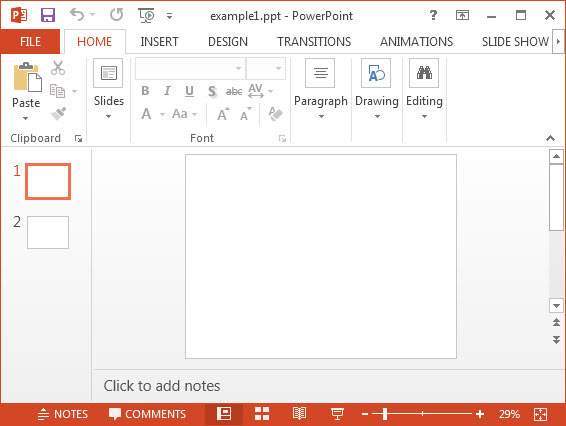 After adding slides to a PPT, you can add, perform, read, and write operations on the slides.
After adding slides to a PPT, you can add, perform, read, and write operations on the slides.Apache POI PPT - Slide Layouts
In the previous chapter, you have seen how to create empty slides and how to add slides to it. In this chapter, you will learn how to get the list of available slides, and how to create a slide with different layouts.Available Slide layouts
PowerPoint presentations have slide layouts, and you can choose a desired layout to edit a slide. First of all, let us find out the list of all the slide layouts available.- There are different slide masters and in each slide master, there are several slide layouts.
- You can get the list of the slide masters using the getSlideMasters() method of the XMLSlideShow class.
- You can get the list of the slide layouts from each slide master using the getSlideLayouts() method of the XSLFSlideMaster class.
- You can get the name of the slide layout from the layout object using the getType() method of the XSLFSlideLayout class.
Given below is the complete program to get the list of available slide layouts in the PPT:
import java.io.FileInputStream; import java.io.FileNotFoundException; import java.io.IOException; import org.apache.poi.xslf.usermodel.XMLSlideShow; import org.apache.poi.xslf.usermodel.XSLFSlideLayout; import org.apache.poi.xslf.usermodel.XSLFSlideMaster; public class SlideLayouts { public static void main(String args[]) throws IOException{ //create an empty presentation XMLSlideShow ppt = new XMLSlideShow(); System.out.println("Available slide layouts:") //getting the list of all slide masters for(XSLFSlideMaster master : ppt.getSlideMasters()){ //getting the list of the layouts in each slide master for(XSLFSlideLayout layout : master.getSlideLayouts()){ //getting the list of available slides System.out.println(layout.getType()); } } } }Save the above Java code as SlideLayouts.java , and then compile and execute it from the command prompt as follows:
$javac SlideLayouts.java $java SlideLayoutsIt will compile and execute to generate the following output:
Available slide layouts: TITLE PIC_TX VERT_TX TWO_TX_TWO_OBJ BLANK VERT_TITLE_AND_TX TITLE_AND_CONTENT TITLE_ONLY SECTION_HEADER TWO_OBJ OBJ_TXShown below are some of the sample slide layouts available with MS-Office 360, 2013 edition.
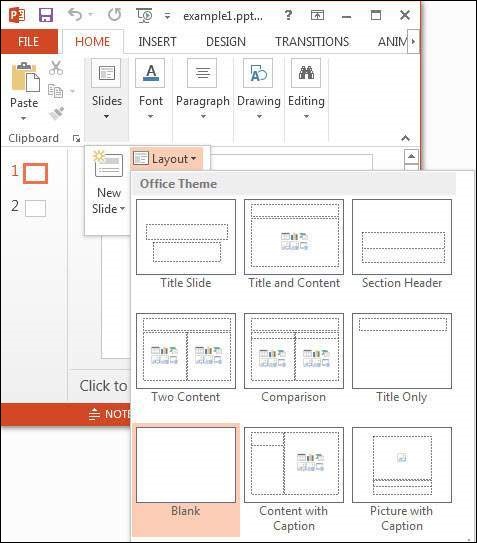
Title Layout
Let us create a slide in a PPT using Title layout. Follow the steps given below:Step 1 : Create an empty presentation by instantiating the XMLSlideShow class as shown below:
XMLSlideShow ppt = new XMLSlideShow();Step 2 : Get the list of slide masters using the getSlideMasters() method. Thereafter, select the desired slide master using the index as shown below:
XSLFSlideMaster slideMaster = ppt.getSlideMasters()[0];Here we are getting the default slide master which is in the 0th location of the slide masters array.
Step 3 : Get the desired layout using the getLayout() method of the XSLFSlideMaster class. This method accepts a parameter where you have to pass one of the static variable of the SlideLayoutclass, which represents our desired layout. There are several variables in this class where each variable represents a slide layout.
The code snippet given below shows how to create a title layout:
XSLFSlideLayout titleLayout = slideMaster.getLayout(SlideLayout.TITLE);Step 4 : Create a new slide by passing a slide layout object as parameter.
XSLFSlide slide = ppt.createSlide(titleLayout);Step 5 : Select a placeholder using the getPlaceholder() method of the XSLFSlide class. This method accepts an integer parameter. By passing 0 to it, you will get the XSLFTextShape object, using which you can access the title text area of the slide. Set the title using the setText() method as shown below:
XSLFTextShape title1 = slide.getPlaceholder(0); //setting the title init title1.setText("Tutorials point");Given below is the complete program to create a slide with Title layout in a presentation:
import java.io.File; import java.io.FileOutputStream; import java.io.IOException; import org.apache.poi.xslf.usermodel.SlideLayout; import org.apache.poi.xslf.usermodel.XMLSlideShow; import org.apache.poi.xslf.usermodel.XSLFSlide; import org.apache.poi.xslf.usermodel.XSLFSlideLayout; import org.apache.poi.xslf.usermodel.XSLFSlideMaster; import org.apache.poi.xslf.usermodel.XSLFTextShape; public class TitleLayout { public static void main(String args[]) throws IOException{ //creating presentation XMLSlideShow ppt = new XMLSlideShow(); //getting the slide master object XSLFSlideMaster slideMaster = ppt.getSlideMasters()[0]; //get the desired slide layout XSLFSlideLayout titleLayout = slideMaster.getLayout(SlideLayout.TITLE); //creating a slide with title layout XSLFSlide slide1 = ppt.createSlide(titleLayout); //selecting the place holder in it XSLFTextShape title1 = slide1.getPlaceholder(0); //setting the title init title1.setText("Tutorials point"); //create a file object File file=new File("C://POIPPT//Examples//Titlelayout.pptx"); FileOutputStream out = new FileOutputStream(file); //save the changes in a PPt document ppt.write(out); System.out.println("slide cretated successfully"); out.close(); } }Save the above Java code as TitleLayout.java, and then compile and execute it from the command prompt as follows:
$javac TitleLayout.java $java TitleLayoutIt will compile and execute to generate the following output.
slide created successfullyThe PPT document with newly added Title layout slide appears as follows:
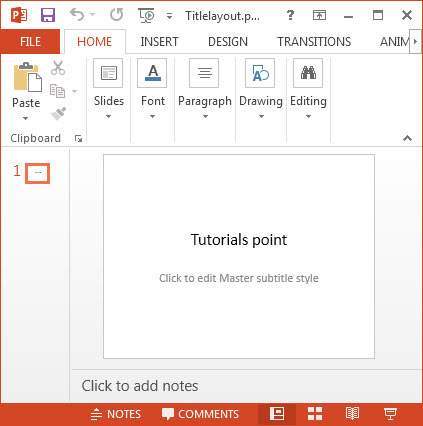
Title and content Layout
Let us create a slide in a PPT using Title and content layout. Follow the steps given below.Step 1 : Create an empty presentation by instantiating the XMLSlideShow class as shown below:
XMLSlideShow ppt = new XMLSlideShow();Step 2 : Get the list of slide masters using the getSlideMasters() method. Select the desired slide master using the index as shown below:
XSLFSlideMaster slideMaster = ppt.getSlideMasters()[0];Here we are getting the default slide master which is in the 0th location of the slide masters array.
Step 3 : Get the desired layout using the getLayout() method of the XSLFSlideMaster class. This method accepts a parameter where you have to pass one of the static variable of the SlideLayout class which represents our desired layout. There are several variables in this class that represent slide layouts.
The following code snippet shows how to create title and content layout:
XSLFSlideLayout contentlayout = slideMaster.getLayout(SlideLayout.TITLE_AND_CONTENT);Step 4 : Create a new slide by passing the slide layout object as parameter.
XSLFSlide slide = ppt.createSlide(SlideLayout.TITLE_AND_CONTENT);Step 5 : Select a placeholder using the getPlaceholder() method of the XSLFSlide class. This method accepts an integer parameter. By passing 1 to it, you will get the XSLFTextShape object, using which you can access the content area of the slide. Set the title using the setText() method as shown below:
XSLFTextShape title1 = slide1.getPlaceholder(1); //setting the title init title1.setText("Introduction");Step 6 : Clear the existing text in the slide using the clearText() method of the XSLFTextShape class.
body.clearText();Step 7 : Add new paragraph using the addNewTextParagraph() method. Now add a new text run to the paragraph using the addNewTextRun() method. Now to the text run, add text using the setText() method as shown below:
body.addNewTextParagraph().addNewTextRun().setText("this is my first slide body");Given below is the complete program to create a slide with Title layout in a presentation:
import java.io.File; import java.io.FileOutputStream; import java.io.IOException; import org.apache.poi.xslf.usermodel.SlideLayout; import org.apache.poi.xslf.usermodel.XMLSlideShow; import org.apache.poi.xslf.usermodel.XSLFSlide; import org.apache.poi.xslf.usermodel.XSLFSlideLayout; import org.apache.poi.xslf.usermodel.XSLFSlideMaster; import org.apache.poi.xslf.usermodel.XSLFTextShape; public class TitleAndBodyLayout { public static void main(String args[]) throws IOException{ //creating presentation XMLSlideShow ppt = new XMLSlideShow(); //getting the slide master object XSLFSlideMaster slideMaster = ppt.getSlideMasters()[0]; //select a layout from specified list XSLFSlideLayout slidelayout = slideMaster.getLayout(SlideLayout.TITLE_AND_CONTENT); //creating a slide with title and content layout XSLFSlide slide = ppt.createSlide(slidelayout); //selection of title place holder XSLFTextShape title = slide.getPlaceholder(0); //setting the title in it title.setText("introduction"); //selection of body placeholder XSLFTextShape body = slide.getPlaceholder(1); //clear the existing text in the slide body.clearText(); //adding new paragraph body.addNewTextParagraph().addNewTextRun().setText("this is my first slide body"); //create a file object File file=new File("contentlayout.pptx"); FileOutputStream out = new FileOutputStream(file); //save the changes in a file ppt.write(out); System.out.println("slide cretated successfully"); out.close(); } }Save the above Java code as TitleLayout.java, and then compile and execute it from the command prompt as follows:
$javac TitleLayout.java $java TitleLayoutIt will compile and execute to generate the following output:
slide created successfullyThe PPT document with newly added Title layout slide appears as follows:
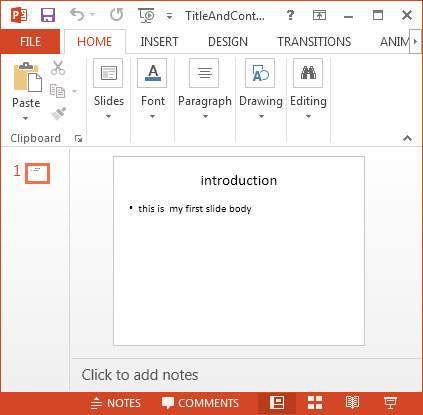 In the same way, you can create slides with different layouts as well.
In the same way, you can create slides with different layouts as well.Apache POI PPT - Management of Slides
After completing this chapter, you will be able to delete, reorder, and perform read and write operations on a slide.Changing a Slide
We can change the page size of a slide using the setPageSize() method of the XMLSlideShow class.Initially create a presentation as shown below:
File file=new File("C://POIPPT//Examples// TitleAndContentLayout.pptx"); //create presentation XMLSlideShow ppt = new XMLSlideShow(new FileInputStream(file));Get the size of the current slide using the getPageSize() method of the XMLSlideShow class.
java.awt.Dimension pgsize = ppt.getPageSize();Set the size of the page using the setPageSize() method.
ppt.setPageSize(new java.awt.Dimension(1024, 768));The complete program for changing the size of a slide is given below:
import java.io.File; import java.io.FileOutputStream; import java.io.IOException; import org.apache.poi.xslf.usermodel.XMLSlideShow; public class ChangingSlide { public static void main(String args[]) throws IOException{ //create file object File file = new File("TitleAndContentLayout.pptx"); //create presentation XMLSlideShow ppt = new XMLSlideShow(); //getting the current page size java.awt.Dimension pgsize = ppt.getPageSize(); int pgw = pgsize.width; //slide width in points int pgh = pgsize.height; //slide height in points System.out.println("current page size of the PPT is:"); System.out.println("width :" + pgw); System.out.println("height :" + pgh); //set new page size ppt.setPageSize(new java.awt.Dimension(2048,1536)); //creating file object FileOutputStream out = new FileOutputStream(file); //saving the changes to a file ppt.write(out); System.out.println("slide size changed to given dimentions "); out.close(); } }Save the above Java code as ChangingSlide.java, and then compile and execute it from the command prompt as follows:
$javac ChangingSlide.java $java ChangingSlideIt will compile and execute to generate the following output.
current page size of the presentation is : width :720 height :540 slide size changed to given dimensionsGiven below is the snapshot of the presentation before changing the slide size:
 The slide appears as follows after changing its size:
The slide appears as follows after changing its size: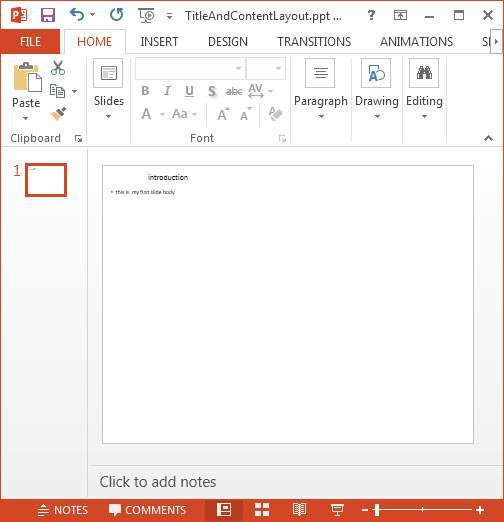
Reordering Slides
You can set the slide order using the setSlideOrder() method. Given below is the procedure to set the order of the slides.Open an existing PPT document as shown below:
File file=new File("C://POIPPT//Examples//example1.pptx"); XMLSlideShow ppt = new XMLSlideShow(new FileInputStream(file));Get the slides using the getSlides() method as shown below:
XSLFSlide[] slides =ppt.getSlides();Select a slide from the array of the slides, and change the order using the setSlideOrder() method as shown below:
//selecting the fourth slide XSLFSlide selectesdslide= slides[4]; //bringing it to the top ppt.setSlideOrder(selectesdslide, 1);Given below is the complete program to reorder the slides in a presentation:
import java.io.File; import java.io.FileInputStream; import java.io.FileOutputStream; import java.io.IOException; import org.apache.poi.xslf.usermodel.XMLSlideShow; import org.apache.poi.xslf.usermodel.XSLFSlide; public class ReorderSlide { public static void main(String args[]) throws IOException{ //opening an existing presentation File file=new File("example1.pptx"); XMLSlideShow ppt = new XMLSlideShow(new FileInputStream(file)); //get the slides XSLFSlide[] slides = ppt.getSlides(); //selecting the fourth slide XSLFSlide selectesdslide = slides[13]; //bringing it to the top ppt.setSlideOrder(selectesdslide, 0); //creating an file object FileOutputStream out = new FileOutputStream(file); //saving the changes to a file ppt.write(out); out.close(); } }Save the above Java code as ReorderSlide.java, and then compile and execute it from the command prompt as follows:
$javac ReorderSlide.java $java ReorderSlideIt will compile and execute to generate the following output.
Reordering of the slides is doneGiven below is the snapshot of the presentation before reordering the slides:
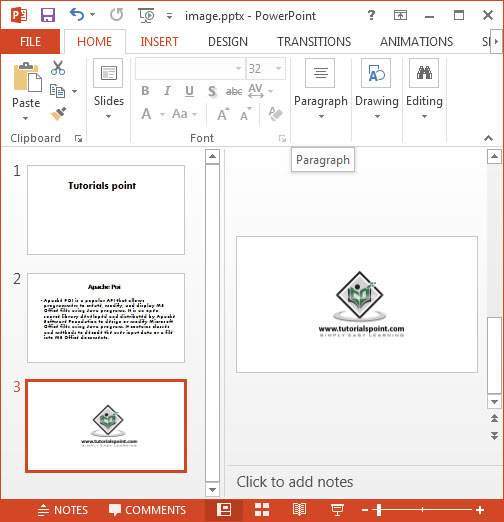 After reordering the slides, the presentation appears as follows.
Here we have selected the slide with image and moved it to the top.
After reordering the slides, the presentation appears as follows.
Here we have selected the slide with image and moved it to the top.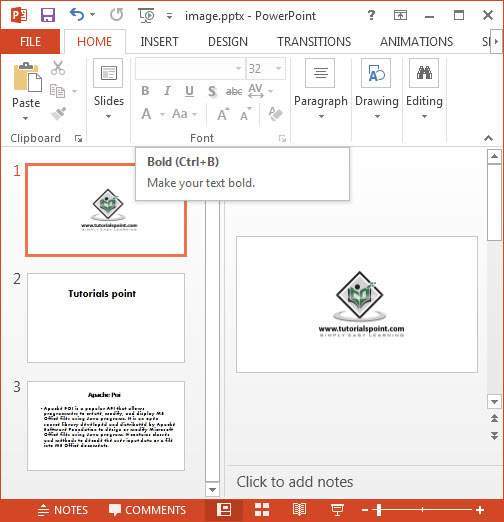
Deleting Slides
You can delete the slides using the removeSlide() method. Follow the steps given below to delete slides.Open an existing presentation using the XMLSlideShow class as shown below:
File file=new File("C://POIPPT//Examples//image.pptx"); XMLSlideShow ppt = new XMLSlideShow(new FileInputStream(file));Delete the required slide using the removeSlide() method. This method accepts an integer parameter. Pass the index of the slide that is to be deleted to this method.
ppt.removeSlide(1);Given below is the program to delete slides from a presentation:
import java.io.File; import java.io.FileInputStream; import java.io.FileOutputStream; import java.io.IOException; import org.apache.poi.xslf.usermodel.XMLSlideShow; public class Deleteslide { public static void main(String args[]) throws IOException{ //Opening an existing slide File file=new File("image.pptx"); XMLSlideShow ppt = new XMLSlideShow(new FileInputStream(file)); //deleting a slide ppt.removeSlide(1); //creating a file object FileOutputStream out = new FileOutputStream(file); //Saving the changes to the presentation ppt.write(out); out.close(); } }Save the above Java code as Deleteslide.java, and then compile and execute it from the command prompt as follows:
$javac Deleteslide.java $java DeleteslideIt will compile and execute to generate the following output:
reordering of the slides is doneThe snapshot below is of the presentation before deleting the slide:
 After deleting the slide, the presentation appears as follows:
After deleting the slide, the presentation appears as follows: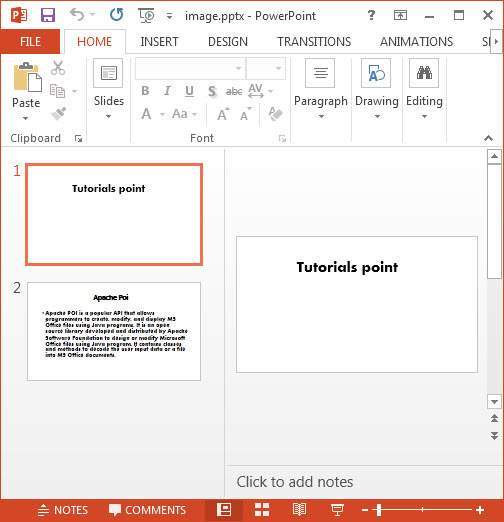
Apache POI PPT - Images
In this chapter, you will learn how to add an image to a PPT and how to read an image from it.Adding Image
You can add images to a presentation using the createPicture() method of XSLFSlide. This method accepts image in the form of byte array format. Therefore, you have to create a byte array of the image that is to be added to the presentation.Follow the given procedure to add an image to a presentation. Create an empty slideshow using XMLSlideShow as shown below:
XMLSlideShow ppt = new XMLSlideShow();Create an empty presentation in it using createSlide().
XSLFSlide slide = ppt.createSlide();Read the image file that is to be added and convert it into byte array using IOUtils.toByteArray() of the IOUtils class as shown below:
//reading an image File image=new File("C://POIPPT//boy.jpg"); //converting it into a byte array byte[] picture = IOUtils.toByteArray(new FileInputStream(image));Add the image to the presentation using addPicture(). This method accepts two variables: byte array format of the image that is to be added and the static variable representing the file format of the image. The usage of the addPicture() method is shown below:
int idx = ppt.addPicture(picture, XSLFPictureData.PICTURE_TYPE_PNG);Embed the image to the slide using createPicture() as shown below:
XSLFPictureShape pic = slide.createPicture(idx);Given below is the complete program to add an image to the slide in a presentation:
import java.io.File; import java.io.FileInputStream; import java.io.FileOutputStream; import java.io.IOException; import org.apache.poi.util.IOUtils; import org.apache.poi.xslf.usermodel.XMLSlideShow; import org.apache.poi.xslf.usermodel.XSLFPictureData; import org.apache.poi.xslf.usermodel.XSLFPictureShape; import org.apache.poi.xslf.usermodel.XSLFSlide; public class AddingImage { public static void main(String args[]) throws IOException{ //creating a presentation XMLSlideShow ppt = new XMLSlideShow(); //creating a slide in it XSLFSlide slide = ppt.createSlide(); //reading an image File image=new File("C://POIPPT//boy.jpg"); //converting it into a byte array byte[] picture = IOUtils.toByteArray(new FileInputStream(image)); //adding the image to the presentation int idx = ppt.addPicture(picture, XSLFPictureData.PICTURE_TYPE_PNG); //creating a slide with given picture on it XSLFPictureShape pic = slide.createPicture(idx); //creating a file object File file=new File("addingimage.pptx"); FileOutputStream out = new FileOutputStream(file); //saving the changes to a file ppt.write(out) System.out.println("image added successfully"); out.close(); } }Save the above Java code as AddingImage.java, and then compile and execute it from the command prompt as follows:
$javac AddingImage.java $java AddingImageIt will compile and execute to generate the following output:
reordering of the slides is doneThe presentation with the newly added slide with image appears as follows:
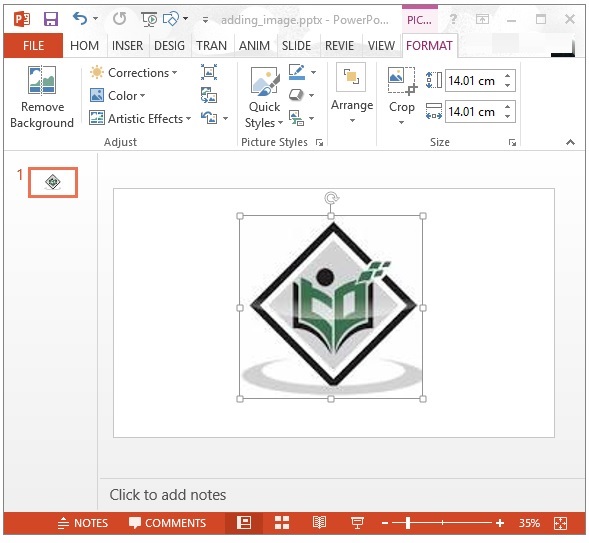
Reading Image
You can get the data of all the pictures using the getAllPictures() method of the XMLSlideShow class. The following program reads the images from a presentation:import java.io.File; import java.io.FileInputStream; import java.io.FileOutputStream; import java.io.IOException; import org.apache.poi.xslf.usermodel.XMLSlideShow; import org.apache.poi.xslf.usermodel.XSLFPictureData; public class Readingimage { public static void main(String args[]) throws IOException{ //open an existing presentation File file = new File("addingimage.pptx"); XMLSlideShow ppt = new XMLSlideShow(new FileInputStream(file)); //reading all the pictures in the presentation for(XSLFPictureData data : ppt.getAllPictures()){ byte[] bytes = data.getData(); String fileName = data.getFileName(); int pictureFormat = data.getPictureType(); System.out.println("picture name: " + fileName); System.out.println("picture format: " + pictureFormat); } //saving the changes to a file FileOutputStream out = new FileOutputStream(file); ppt.write(out); out.close(); } }Save the above Java code as Readingimage.java, and then compile and execute it from the command prompt as follows:
$javac Readingimage.java $java ReadingimageIt will compile and execute to generate the following output:
picture name: image1.png picture format: 6
Apache POI PPT - Creating Hyperlinks
In this chapter you will learn how to create hyperlinks in a presentation.Creating Hyperlinks
You can read the hyperlinks in a presentation using the createHyperlink() method of the XSLFTextRun class. Follow the procedure given below to create a hyperlink in a presentation.Create an empty presentation using the XMLSlideShow class as shown below:
XMLSlideShow ppt = new XMLSlideShow();Create an empty slide and create a textbox and body of the slide using body and content layout.
//create an empty presentation XSLFSlideMaster slideMaster = ppt.getSlideMasters()[0]; //creating a slide with title and content layout XSLFSlideLayout slidelayout = slideMaster.getLayout(SlideLayout.TITLE_AND_CONTENT); XSLFSlide slide = ppt.createSlide(slidelayout); //selection of body place holder XSLFTextShape body = slide.getPlaceholder(1); //clear the existing text in the slide body.clearText();Create a text run object and set text to it as shown below:
XSLFTextRun textRun=body.addNewTextParagraph().addNewTextRun(); textRun.setText("Tutorials point");Create a hyperlink using the createHyperlink() method of the XSLFTextRun class as shown below:
XSLFHyperlink link = textRun.createHyperlink();Set the link address to the hyperlink using the setAddress() method of XSLFHyperlink class as shown below:
link.setAddress("http://www.tutorialspoint.com/");Given below is the complete program to create hyperlink in a presentation:
import java.io.File; import java.io.FileOutputStream; import java.io.IOException; import org.apache.poi.xslf.usermodel.SlideLayout; import org.apache.poi.xslf.usermodel.XMLSlideShow; import org.apache.poi.xslf.usermodel.XSLFHyperlink; import org.apache.poi.xslf.usermodel.XSLFSlide; import org.apache.poi.xslf.usermodel.XSLFSlideLayout; import org.apache.poi.xslf.usermodel.XSLFSlideMaster; import org.apache.poi.xslf.usermodel.XSLFTextRun; import org.apache.poi.xslf.usermodel.XSLFTextShape; public class CreatingHyperlinks { public static void main(String args[]) throws IOException{ //create an empty presentation XMLSlideShow ppt = new XMLSlideShow(); //getting the slide master object XSLFSlideMaster slideMaster = ppt.getSlideMasters()[0]; //select a layout from specified list XSLFSlideLayout slidelayout = slideMaster.getLayout(SlideLayout.TITLE_AND_CONTENT); //creating a slide with title and content layout XSLFSlide slide = ppt.createSlide(slidelayout); //selection of title place holder XSLFTextShape body = slide.getPlaceholder(1); //clear the existing text in the slid body.clearText(); //adding new paragraph XSLFTextRun textRun = body.addNewTextParagraph().addNewTextRun(); //setting the text textRun.setText("Tutorials point"); //creating the hyperlink XSLFHyperlink link = textRun.createHyperlink(); //setting the link address link.setAddress("http://www.tutorialspoint.com/"); //create the file object File file=new File("hyperlink.pptx"); FileOutputStream out = new FileOutputStream(file); //save the changes in a file ppt.write(out); System.out.println("slide cretated successfully"); out.close(); } }Save the above Java code as CreatingHyperlinks.java, and then compile and execute it from the command prompt as follows:
$javac CreatingHyperlinks.java $java CreatingHyperlinksIt will compile and execute to generate the following output:
slide cretated successfullyThe newly added slide with the hyperlink in its body looks as follows:
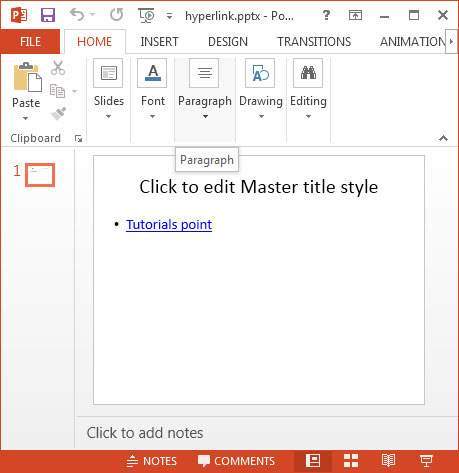
Apache POI PPT - Reading Shapes
Reading Shapes from a Presentation
You can get a count of the number of shapes used in a presentation using the method getShapeName() of the XSLFShape class. Given below is the program to read the shapes from a presentation:import java.io.File; import java.io.FileInputStream; import java.io.FileOutputStream; import java.io.IOException; import org.apache.poi.xslf.usermodel.XMLSlideShow; import org.apache.poi.xslf.usermodel.XSLFShape; import org.apache.poi.xslf.usermodel.XSLFSlide; public class ReadingShapes { public static void main(String args[]) throws IOException{ //creating a slideshow File file = new File("shapes.pptx"); XMLSlideShow ppt = new XMLSlideShow(new FileInputStream(file)); //get slides XSLFSlide[] slide = ppt.getSlides(); //getting the shapes in the presentation System.out.println("Shapes in the presentation:"); for (int i = 0; i < slide.length; i++){ XSLFShape[] sh = slide[i].getShapes(); for (int j = 0; j < sh.length; j++){ //name of the shape System.out.println(sh[j].getShapeName()); } } FileOutputStream out = new FileOutputStream(file); ppt.write(out); out.close(); } }Save the above Java code as ReadingShapes.java, and then compile and execute it from the command prompt as follows:
$javac ReadingShapes.java $java ReadingShapesIt will compile and execute to generate the following output.
Shapes in the presentation: Rectangle 1 Oval 1 Isosceles Triangle 1The newly added slide with the various shapes appears as follows:
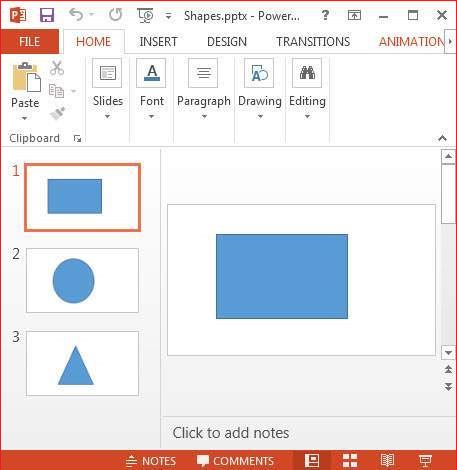
Apache POI PPT - Formatting Text
Formatting Text in a Presentation
The text in a presentation can be formatted using the methods of the XSLFTextRun class. For that, you have to create an XSLFTextRun class object by selecting one of the slide layouts as shown below://create the empty presentation XMLSlideShow ppt = new XMLSlideShow(); //getting the slide master object XSLFSlideMaster slideMaster = ppt.getSlideMasters()[0]; //select a layout from specified list XSLFSlideLayout slidelayout = slideMaster.getLayout(SlideLayout.TITLE_AND_CONTENT); //creating a slide with title and content layout XSLFSlide slide = ppt.createSlide(slidelayout); //selection of title place holder XSLFTextShape body = slide.getPlaceholder(1); //clear the existing text in the slide body.clearText(); //adding new paragraph XSLFTextParagraph paragraph=body.addNewTextParagraph(); //creating text run object XSLFTextRun run = paragraph.addNewTextRun();You can set the font size of the text in the presentation using setFontSize().
run.setFontColor(java.awt.Color.red); run.setFontSize(24);The following code snippet shows how to apply different formatting styles (bold, italic, underline, strikeout) to the text in a presentation.
//change the text into bold format run.setBold(true); //change the text it to italic format run.setItalic(true) // strike through the text run.setStrikethrough(true); //underline the text run.setUnderline(true);To have line breaks between paragraphs, use addLineBreak() of the XSLFTextParagraph class as shown below:
paragraph.addLineBreak();Given below is the complete program to format the text using all the above methods:
import java.io.FileOutputStream; import java.io.IOException; import org.apache.poi.xslf.usermodel.SlideLayout; import org.apache.poi.xslf.usermodel.XMLSlideShow; import org.apache.poi.xslf.usermodel.XSLFSlide; import org.apache.poi.xslf.usermodel.XSLFSlideLayout; import org.apache.poi.xslf.usermodel.XSLFSlideMaster; import org.apache.poi.xslf.usermodel.XSLFTextParagraph; import org.apache.poi.xslf.usermodel.XSLFTextRun; import org.apache.poi.xslf.usermodel.XSLFTextShape; public class TextFormating { public static void main(String args[]) throws IOException{ //creating an empty presentation XMLSlideShow ppt = new XMLSlideShow(); //getting the slide master object XSLFSlideMaster slideMaster = ppt.getSlideMasters()[0]; //select a layout from specified list XSLFSlideLayout slidelayout = slideMaster.getLayout(SlideLayout.TITLE_AND_CONTENT); //creating a slide with title and content layout XSLFSlide slide = ppt.createSlide(slidelayout); //selection of title place holder XSLFTextShape body = slide.getPlaceholder(1); //clear the existing text in the slide body.clearText(); //adding new paragraph XSLFTextParagraph paragraph=body.addNewTextParagraph(); //formatting line1 XSLFTextRun run1 = paragraph.addNewTextRun(); run1.setText("This is a colored line"); //setting color to the text run1.setFontColor(java.awt.Color.red); //setting font size to the text run1.setFontSize(24); //moving to the next line paragraph.addLineBreak(); //formatting line2 XSLFTextRun run2 = paragraph.addNewTextRun(); run2.setText("This is a bold line"); run2.setFontColor(java.awt.Color.CYAN); //making the text bold run2.setBold(true); paragraph.addLineBreak(); //formatting line3 XSLFTextRun run3 = paragraph.addNewTextRun(); run3.setText(" This is a striked line"); run3.setFontSize(12); //making the text italic run3.setItalic(true); //strike through the text run3.setStrikethrough(true); paragraph.addLineBreak(); //formatting line4 XSLFTextRun run4 = paragraph.addNewTextRun(); run4.setText(" This an underlined line"); run4.setUnderline(true); //underlining the text paragraph.addLineBreak(); //creating a file object File file=new File(“TextFormat.pptx”); FileOutputStream out = new FileOutputStream(file); saving the changes to a file ppt.write(out); out.close(); } }Save the above code as TextFormating.java, and then compile and execute it from the command prompt as follows:
$javac TextFormating.java $java TextFormatingIt will compile and execute to generate the following output:
Formatting completed successfullyThe slide with formatted text appears as follows:
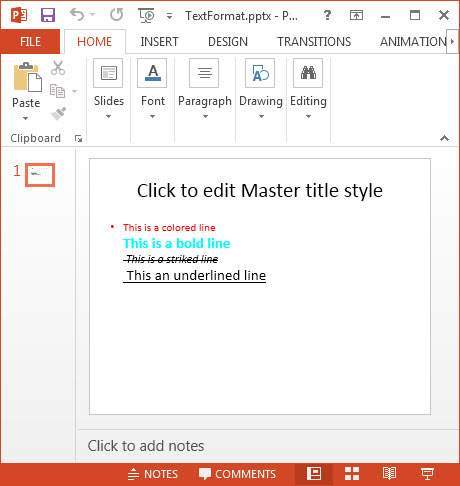
Apache POI PPT - Merging
Merging Multiple Presentations
You can merge multiple presentations using the importContent() method of the XMLSlideShow class. Given below is the complete program to merge two presentations:import java.io.FileInputStream; import java.io.FileOutputStream; import java.io.IOException; import org.apache.poi.xslf.usermodel.XMLSlideShow; import org.apache.poi.xslf.usermodel.XSLFSlide; public class MergingMultiplePresentations { public static void main(String args[]) throws IOException{ //creating empty presentation XMLSlideShow ppt = new XMLSlideShow(); //taking the two presentations that are to be merged String file1 = "presentation1.pptx"; String file2 = "presentation2.pptx"; String[] inputs = {file1, file2}; for(String arg : inputs){ FileInputStream inputstream = new FileInputStream(arg); XMLSlideShow src = new XMLSlideShow(inputstream); for(XSLFSlide srcSlide : src.getSlides()){ //merging the contents ppt.createSlide().importContent(srcSlide); } } String file3 = "combinedpresentation.pptx"; //creating the file object FileOutputStream out = new FileOutputStream(file3); // saving the changes to a file ppt.write(out); System.out.println("Merging done successfully"); out.close(); } }Save the above code as MergingMultiplePresentations.java, and then compile and execute it from the command prompt as follows:
$javac MergingMultiplePresentations.java $java MergingMultiplePresentationsIt will compile and execute to generate the following output:
Merging done successfullyThe following snapshot shows the first presentation:
 The following snapshot shows the second presentation:
The following snapshot shows the second presentation: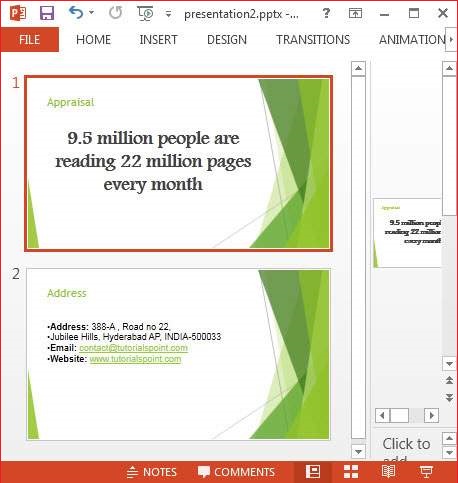 Given below is the output of the program after merging the two
slides. Here you can see the content of the earlier slides merged
together.
Given below is the output of the program after merging the two
slides. Here you can see the content of the earlier slides merged
together.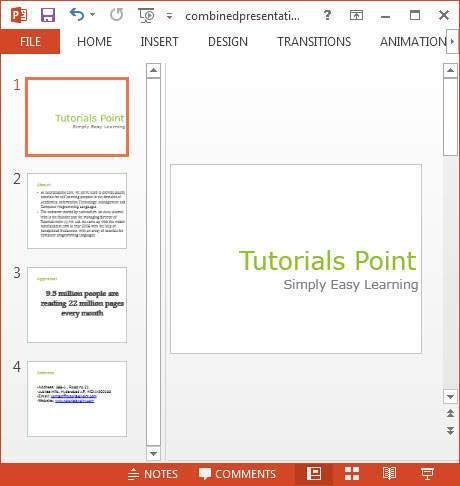
Apache POI PPT - PPT to Image
Converting Presentation to Image
You can convert a presentation to an image file. The following program shows how to go about it.import java.io.File; import java.io.FileInputStream; import java.io.FileOutputStream; import java.io.IOException; import org.apache.poi.xslf.usermodel.XMLSlideShow; import org.apache.poi.xslf.usermodel.XSLFSlide; public class PpttoPNG { public static void main(String args[]) throws IOException{ //creating an empty presentation File file=new File("addingimage.pptx"); XMLSlideShow ppt = new XMLSlideShow(new FileInputStream(file)); //getting the dimensions and size of the slide Dimension pgsize = ppt.getPageSize(); XSLFSlide[] slide = ppt.getSlides(); for (int i = 0; i < slide.length; i++) { BufferedImage img = new BufferedImage(pgsize.width, pgsize.height,BufferedImage.TYPE_INT_RGB); Graphics2D graphics = img.createGraphics(); //clear the drawing area graphics.setPaint(Color.white); graphics.fill(new Rectangle2D.Float(0, 0, pgsize.width, pgsize.height)); //render slide[i].draw(graphics); //creating an image file as output FileOutputStream out = new FileOutputStream("ppt_image.png"); javax.imageio.ImageIO.write(img, "png", out); ppt.write(out); System.out.println("Image successfully created"); out.close(); } }Save the above Java code as PpttoPNG.java, and then compile and execute it from the command prompt as follows:
$javac PpttoPNG.java $java PpttoPNGIt will compile and execute to generate the following output:
Image created successfullyThe following snapshot shows the presentation that is given as input:
 Given below is the snapshot of the image created at the specified location.
Given below is the snapshot of the image created at the specified location.

No comments:
Post a Comment